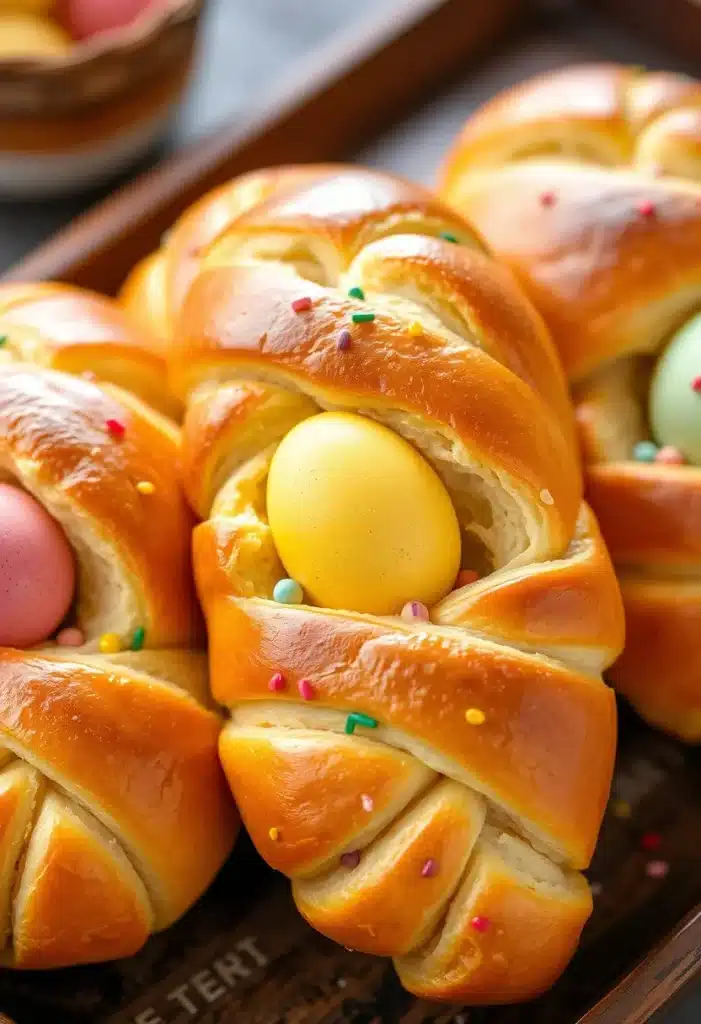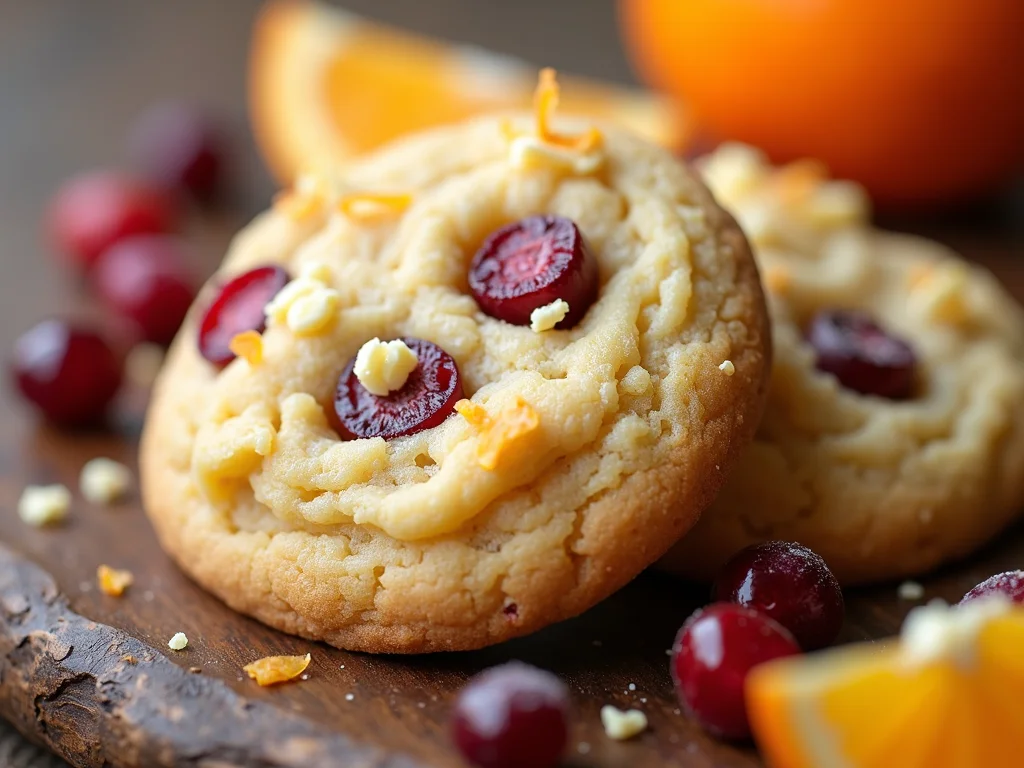Get ready to weave a little magic into your Easter with this Italian Easter Bread! This soft, pillowy braided loaf, adorned with vibrant dyed eggs and a shower of sprinkles, is a stunning centerpiece that tastes as good as it looks. Ready in about 3 hours, it’s a festive tradition that fills your kitchen with warmth and joy.
I’m enchanted by this recipe because it’s a beautiful blend of sweet dough, subtle citrus, and holiday spirit. Perfect for Easter brunch or gifting, it’s a showstopper that brings everyone together. Let’s bake this delightful bread!
Why I Love This Recipe
This bread is a holiday treasure. It’s fun to make, with braiding and egg-nesting that feel like crafting a masterpiece. The dough is soft, slightly sweet, and infused with citrusy zest.
It’s a crowd-pleaser, loved by kids and adults for its festive look and flavor. Great for Easter celebrations or spring gatherings, it’s a tradition worth keeping. Plus, it’s surprisingly doable for home bakers.
Ingredients for Italian Easter Bread
Here’s what you’ll need:
- All-purpose flour: 4 cups, for a soft, sturdy dough.
- Granulated sugar: ½ cup, for sweetness.
- Active dry yeast: 2¼ tsp (1 packet), for rising.
- Milk: ¾ cup, warm (110°F), to activate yeast.
- Butter: ⅓ cup, melted and cooled, for richness.
- Eggs: 2 large, for dough, plus 4-6 small raw eggs for decoration (dyed).
- Vanilla extract: 1 tsp, for flavor.
- Lemon zest: 1 tbsp, for citrusy brightness.
- Salt: 1 tsp, for balance.
- Sprinkles: 2 tbsp, for festive decoration.
- Egg wash: 1 egg beaten with 1 tbsp water, for golden shine.
These ingredients create a classic, festive loaf.
How to Make the Perfect Italian Easter Bread
Let’s bake this beauty:
- In a small bowl, combine warm milk, yeast, and 1 tbsp sugar. Let sit for 5-10 minutes until foamy, signaling active yeast.
- In a large bowl or stand mixer, mix 3½ cups flour, remaining sugar, salt, and lemon zest. Add yeast mixture, melted butter, 2 eggs, and vanilla. Knead for 8-10 minutes, adding remaining flour as needed, until a soft, smooth dough forms.
- Place dough in a greased bowl, cover with a damp cloth, and let rise in a warm place for 1-1½ hours until doubled in size.
- Punch down dough and divide into 2 equal pieces. Roll each into a 24-inch rope. Twist ropes together and form a ring, pinching ends to seal. Place on a parchment-lined baking sheet.
- Nestle 4-6 dyed raw eggs into the dough, spacing evenly. Cover loosely and let rise for 30-45 minutes until puffy. Preheat oven to 350°F (175°C).
- Brush dough with egg wash, avoiding eggs, and sprinkle with sprinkles. Bake for 25-30 minutes until golden and cooked through (internal temp 190°F).
- Cool on a rack for 15 minutes before serving. Eggs will cook during baking and are edible.
It’s like crafting a sweet, edible Easter wreath!
Tips for the Best Italian Easter Bread
To make your bread perfect:
- Use warm (not hot) milk to activate yeast. Too hot (above 120°F) kills yeast; too cold slows rising.
- Dye raw eggs before baking; they’ll cook in the oven. Use food-safe dye and handle gently.
- Don’t over-knead; stop when dough is smooth and elastic. Too much flour makes it dense.
- Let dough rise in a warm, draft-free spot. A turned-off oven with the light on works great.
- Check doneness with a thermometer. Bread should be golden and sound hollow when tapped.
These tips are like the perfect braid—they keep it flawless.
Customizing Your Italian Easter Bread
Make it your own:
- Swap lemon zest for orange zest or anise extract for a different flavor twist.
- Add ½ cup raisins or dried cranberries to the dough for pops of sweetness.
- Use pastel or glitter sprinkles for extra festive flair. Match your Easter theme.
- Shape into individual rolls instead of a ring. Nestle one egg per roll for cute servings.
- Brush with a glaze (1 cup powdered sugar + 1 tbsp milk) after baking for a sweet finish.
Tweak it like you’re decorating an Easter basket!
Nutrition Per Serving
Here’s the approximate nutritional breakdown per serving (based on 12 servings, including 4 dyed eggs):
- Calories: 260 kcal
- Protein: 8 g
- Fat: 8 g (Saturated Fat: 4 g)
- Carbohydrates: 38 g (Dietary Fiber: 1 g, Sugars: 10 g)
- Cholesterol: 85 mg
- Sodium: 230 mg
Note: Nutrition varies based on egg size, flour type, or add-ins like raisins. For precise values, use a nutrition calculator with your ingredients. This bread is a festive treat, best enjoyed in moderation.
Storage Instructions
Keep your bread fresh:
- Store in an airtight container at room temperature for up to 2 days or in the fridge for 4-5 days.
- Remove dyed eggs before storing to prevent moisture buildup. Store eggs separately in the fridge.
- Freeze baked bread (without eggs) for up to 2 months, wrapped tightly in plastic and foil. Thaw at room temp.
- Reheat slices in a 300°F oven for 5 minutes to revive freshness. Serve at room temp or warm.
This bread is great for gifting or enjoying later.
Serving Suggestions
This bread is a holiday star:
- Serve as a centerpiece for Easter brunch with butter or jam. Pairs beautifully with coffee or tea.
- Offer as a side with ham, lamb, or roasted veggies for a festive Easter dinner.
- Slice and share at spring gatherings or church potlucks. It’s a conversation starter.
- Use leftovers for French toast or bread pudding. Adds a sweet, citrusy twist.
It’s ready to shine at any Easter celebration.
FAQs
What is Italian Easter called?
Italian Easter is called “Pasqua”.
What are the ingredients in making bread?
Basic bread ingredients include flour, water, yeast, salt, and sometimes sugar or oil, depending on the recipe.
What is the traditional gift for Easter in Italy?
A traditional gift is a chocolate Easter egg, often hollow with a surprise inside.
What is a traditional Easter menu?
It often includes lamb, eggs, bread, artichokes, pasta dishes, and a sweet like Colomba di Pasqua (Easter dove cake).
What do Italians drink on Easter?
Italians may drink wine (like Chianti or Prosecco), or a festive digestif like limoncello or amaro after meals.
What food is eaten on Easter Sunday?
Common dishes include roast lamb, lasagna, Easter bread, hard-boiled eggs, and seasonal vegetables.
What is in babka bread?
Babka is a sweet, yeast-based bread made with flour, eggs, sugar, butter, and filled with chocolate or cinnamon swirls.
Why is bread a symbol of Easter?
Bread symbolizes life, nourishment, and resurrection, reflecting the Last Supper and Christ’s role as the “bread of life.”
Why This Recipe Works
This Italian Easter Bread is a holiday gem. It’s festive, with a soft, sweet dough that’s easy to work with. The dyed eggs and sprinkles add visual charm, making it a stunning centerpiece.
The citrusy, buttery flavor is universally loved, balancing richness and lightness. It’s doable for beginners yet impressive for guests. Perfect for Easter or spring, it’s a tradition that warms hearts.
Try More Easy Recipes:-
- Jimmy Carter’s Grandmother’s Peanut Butter Cookies
- Pink Salt Trick Recipe: Easy & Hydrating Drink
- Peanut Butter Cookies Recipe (Just 3 Ingredients)
- Epic Pizza Hut-Inspired Homemade Dough Recipe
Final Thoughts
This Italian Easter Bread is your key to a festive, flavorful celebration. Soft braided dough, colorful eggs, and sweet sprinkles come together in about 3 hours. Ideal for Easter brunch, dinner, or gifting.
Tweak it with orange zest or raisins, and serve with coffee or ham. Grab your ingredients, braid it up, and enjoy. What’s your Easter twist? Let’s bake this bread!



